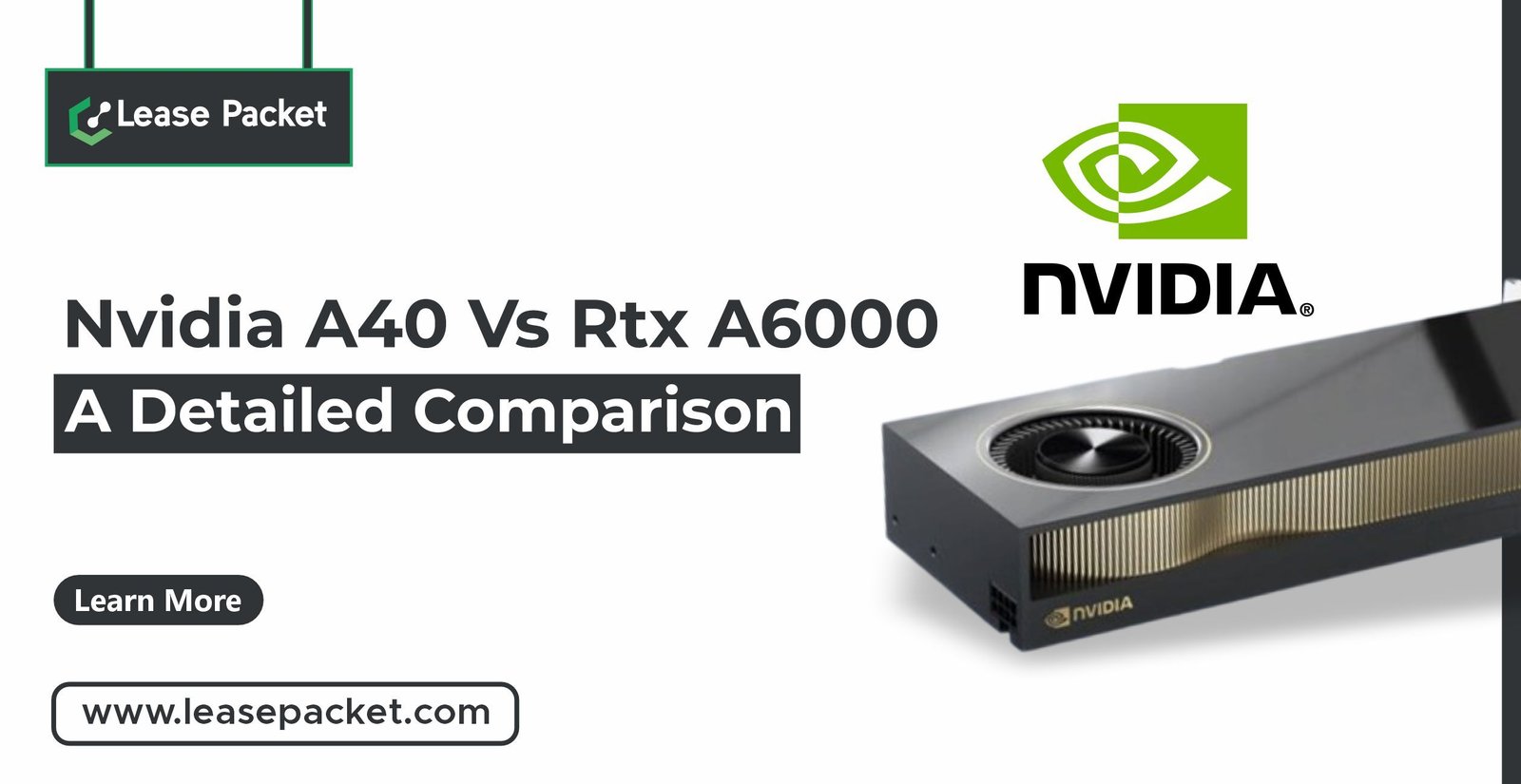Whether a small startup or a large enterprise, having the right GPU is crucial for performance, productivity, and a better user experience. A good graphics card can make a difference. But before investing in super-powered machines, you need to identify the needs of your business. If the workload can be handled with budget GPUs, then there is no need to have GPUs like the NVIDIA A100 or H100.
This blog compares the NVIDIA A40 and the RTX A6000, exploring their specifications, performance, use cases, and value for money. After reading this, you will know more clearly which GPU is best for your particular requirements.
Introduction to the NVIDIA A40 and RTX A6000
About the NVIDIA A40
Mainly, NVIDIAA40 is used for data centres and professional workloads. NVIDIA is built on the Ampere architecture, which has the highest performance across various applications. The A40 is a versatile GPU, combining the features of both a data centre GPU and a high-end professional graphics card.
About the NVIDIA RTX A6000
The RTX A6000 is also built on Ampere architecture. It is designed for high-end workstations and is perfect for tasks such as 3D rendering, video editing, and other GPU-intensive tasks. The RTX A6000 is one of the most powerful GPUs in NVIDIA’s lineup, providing top-tier performance for professional workflows.
Architecture and Technology of the NVIDIA A40 and RTX A6000
| S.N. | Ampere Architecture | NVIDIA A40 | NVIDIA RTX A6000 |
| 1. | CUDA cores | The A40 has 10,752 CUDA cores. | The RTX A6000 also boasts 10,752 CUDA cores. |
| 2. | Tensor cores | Both GPUs are equipped with third-generation tensor cores, which are specialized for AI and machine learning loads. The A40 has 336 tensor cores. | It also has 336 cores. |
| 3. | RT cores | Real-time ray tracing performance is greatly enhanced by the second-generation RT (ray tracing) cores in these GPUs. Ray tracing is essential for photorealistic rendering in graphics and is widely used in gaming, animation, and other visualization tasks. It has 84 RT cores. | The RTX A6000 also has 84 RT cores. |
| 4. | Memory architecture | Both the A40 and RTX A6000 feature 48 GB of GDDR6 ECC memory, providing ample memory bandwidth for large datasets, complex scenes, and multiple applications running simultaneously. The memory speed is 16 Gbps, with a memory bandwidth of 768 GB/s. | It also has the same as A40. |
Key differences in architecture
As we discussed above, both GPUs have many similarities, but they also have some differences. Such as:
Power consumption
the power consumption of the A40 is around 300 watts; the RTX A6000 is slightly lower at 300 watts as well. Both require additional power connectors to function optimally.
Form factor
The A40 is specifically intended for data centres and is passively cooled, making it excellent for server applications. It has a double-slot form factor and no display outputs. The RTX A6000, meant for workstations, features active cooling and a similar double-slot form factor, although it offers four DisplayPort 1.4a outputs.
Features and their performance benchmark
NVIDIA A40 Performance Benchmarks:
- Rendering and workloads: it is ideal for rendering tasks in data centres with multiple GPUs working together.
- AI and deep learning: Excels in large-scale AI model training, suitable for deployment in data centres where clusters of GPUs are used.
- Gaming and real-time ray tracing: capable of gaming but not optimized for it. The lack of display outputs and focus on data centre tasks make it less suitable for gaming.
NVIDIA RTX A600 Performance Benchmarks:
Rendering and workloads
better for real-time rendering and viewpoint manipulation in professional workstations. Active cooling and display outputs enhance usability.
AI and deep learning
Suitable for workstations where a combination of tasks is performed.
Gaming and real-time ray tracing
A strong contender for gaming with real-time ray tracing support, capable of handling modern AAA games at high settings. Ideal for game developers and professionals who enjoy gaming.
Cases of the NVIDIA A40 and RTX A6000
Use cases of NVIDIA A40:
- Data Centers: The A40’s design is perfect for data centre environments where multiple GPUs are used in tandem for AI, rendering, and virtualization tasks. Its passive cooling allows it to be densely packed into servers, making it ideal for large-scale deployments.
- AI and Machine Learning: The A40 is highly effective for AI and machine learning workloads, particularly in environments where large models need to be trained across multiple GPUs.
- Virtualization: The A40’s support for vGPU technology makes it ideal for virtual desktop infrastructure (VDI) and other virtualization tasks in data centres.
Use case of the NVIDIA RTX A6000:
- Professional Workstations: The RTX A6000 is designed for high-end workstations, making it perfect for tasks such as 3D rendering, video editing, and other GPU-intensive workloads.
- Content Creation: For content creators working with high-resolution video, complex 3D models, and real-time rendering, the RTX A6000 provides the performance needed to handle these demanding tasks.
- AI Development: While the A40 excels in large-scale AI deployments, the RTX A6000 is well-suited for AI development and experimentation on a workstation, offering versatility across different types of workloads.
Thinking about a GPU server?
A GPU server helps to accelerate many tasks with the help of multiple GPU units, making it ideal for applications in AI, machine learning, data analysis, and high-performance computing. It significantly enhances processing speed, enabling real-time data processing, complex simulations, and rendering tasks in various industries.
If you are thinking about GPU server integration for your organization, you can consider LeasePacket, as they provide the best GPU server service.
Why LeasePacket as a GPU server provider?
- Easy to use and user-friendly
- Global data centres.
- A cost-effective alternative
- Innovation on the Go
- Up to 100Gbps GB of dedicated ports are available.
- Before we speak, we listen.
- Seamless management tools
- Dedicated 24/7 server security
Conclusion
Both the NVIDIA A40 and the RTX A6000 provide outstanding performance, and they are the best in their respective categories. Both use the Ampere architecture, which provides robust performance for data centres and workstation applications, while their differences cater to the unique demands of each environment. As technology continues to advance, the line between professional and consumer GPUs may blur further, but for now, the A40 and RTX A6000 represent the best of what NVIDIA has to offer in their specialized fields.
Selecting the right GPU is important for enhancing productivity and overall performance.
This blog includes all the necessary information and details to decide on selecting a GPU. If you still have any doubts, then contact our support team.




